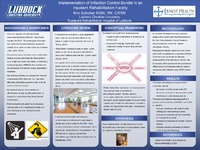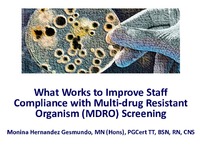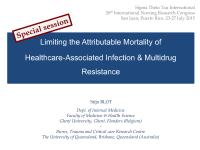| dc.contributor.author | Schober, Kim | en |
| dc.date.accessioned | 2016-07-13T11:13:20Z | |
| dc.date.available | 2016-07-13T11:13:20Z | |
| dc.date.issued | 2016-07-13 | |
| dc.identifier | INRC16PST314 | en |
| dc.identifier.uri | http://hdl.handle.net/10755/616471 | en |
| dc.description | <p>Theme: Leading Global Research: Advancing Practice, Advocacy, and Policy</p> | en |
| dc.description.abstract | <p>Session presented on Saturday, July 23, 2016 and Sunday, July 24, 2016:</p>
<p><strong>Purpose:</strong> The CDC reported 721,800 Healthcare Associated Infections (HAIs) in United States hospitals for 2013. The report goes on to state over half of the reported infections developed outside of the intensive units ("Data and Statistics HAI CDC," 2015). The primary source of admission to rehabilitation facilities is acute care hospitals where patients have a high rate of skin colonization of multi-drug resistant organisms (MDROs) that could lead to the development of infection during rehabilitation treatment. Increased time on isolation during rehabilitation been shown to have adverse effects on the patient's length of stay (Colorado, Del Torro, & Tarima, 2014). Two-tiered isolation is modeled after evidence-based techniques. Isolation is only implemented on patients with MDROs or infectious diseases that would traditionally be isolated in any acute care facility. The two tiers of isolation are referred to as 'In-Room Isolation' and 'Out-of-Room Isolation.' As a vital member of the healthcare community, rehabilitation facilities are faced with the goal of decreasing HAIs within their facilities and within the community. As patient care advocates, rehabilitation facilities also have a goal of returning patients to their homes as soon as possible. These two goals must be balanced by educating patients in infection control self-care. Infection control self-care allows the patient to protect themselves and the other patients while in the facility, and to protect the community upon discharge. The purpose of this project is to determine whether the implementation of admission and daily showers along with a two tiered isolation policy reduce the infection rates in an inpatient rehabilitation facility?</p>
<p><strong>Methods:</strong> In this project, will will evaluate infection rates in a free standing IRF prior to and after implementing the infection control bundle. Staff, patients and visitors will be educated prior to implementation and follow up education will be provided as needed. It is expected that the infection rates will be lower following implementation of the infection control bundle. Retrospective infection rates from a six-month period will be compared to prospective infection rates from a six-month period following implementation of the infection control bundle. Prior to implementation of the infection control bundle, the staff will be educated on the entire bundle of interventions in the bundle. The nursing and all therapy staff will sign an in-service sign-in sheet after watching a 15-minute video recording outlining all steps within the bundle. The nursing in-service will be provided on monitors in the nurses' station that will play every two hours, 24 hours per day for one week. Therapy will view the same video during a lunch-and-learn session where all therapists are required to attend. A written copy of the definitions, allowances, exclusions, and criteria for in-room and out-of-room isolation will be provided for each nurse and therapist. Housekeeping will be educated on room cleaning techniques. When the patient leaves the room while on isolation, the room must be thoroughly cleaned by housekeeping. Education will be completed utilizing a 15-minute video describing the process and products to be utilized when cleaning a patient's room who is infected with an MDRO or C. diff (Thrall, 2013). Consistency in the housekeeping process is vital in reducing transmission of MDROs in the IRF. Hand washing reminder posters will be placed above all sinks including sinks in patient rooms and the rehabilitation gym. Nursing and therapy will be reminded to utilize standard precautions for all patients at all times. Patients with a known infection will have appropriate personal protective gear available outside the patient's room. When a patient is admitted to the facility with an MDRO or develops an MDRO infection while in the facility, the infection control nurse will determine the type of isolation for the patient needs, and a copy of the appropriate isolation procedures will be placed in the patient's room. The staff will be instructed to contact the infection control nurse or a supervisor if any questions arise. Prior to admission to the IRF, all patients will be given written and oral instructions on the admission and daily baths expectations for every patient. Patients will be educated on the importance of hand washing due to the spread of micro organisms in the IRF. This information will be provided by the rehabilitation intake personnel when they meet the patient prior to admission Upon admission, the above information will be reinforced and implemented by the nursing staff. All staff will model good hand washing before and after patient contact. Nursing staff will implement the admission showers and daily showers as soon as possible. All patients infected will be provided with CHG soap, non-infected patients will be provided with regular body soap and hand soap. Patients will be instructed to wash hands prior to eating, after using the bathroom, prior to leaving their rooms. Therapy will participate in encouraging patients to wash hands prior to and after utilizing equipment in the rehabilitation gym. Patients who do not have C. diff will be allowed to utilize alcohol based hand sanitizer instead of soap and water for no more than two consecutive hand washings. Alcohol based hand sanitizers will be available throughout the facility and in each patient room for the patients' convenience. C. diff patients will be required to use soap and water for every hand washing. Patients with known MDRO infections will be instructed on the infectious process of the specific MDRO causing their infection. Transmission of the infection will be discussed, as well as how to avoid transmission of the organism to others while in the IRF, and when the patient discharges to home and the community. Oral and written education will be provided to the patient. Education will be provided to the all visitors on the importance of hand washing. Visitors will be encouraged to wash hands upon entering a patient's room, and especially when exiting the patient room and the facility. A hand sanitization station with alcohol based hand sanitizer will be stationed at the front door and multiple places through out the facility for visitors' convenience. Visitors of patients on isolation will be instructed to wear protective equipment such as gowns, gloves, and masks when participating in the patient's care. Visitors who will live with the patient upon discharge will also be provided with the same education given to the patient on organism transmission and prevention.</p>
<p><strong>Results:</strong> The results of this EBP project are in progress.</p>
<p><strong>Conclusion:</strong> It is expected that the implementation of the EBP infection control bundle will decrease the MDRO infection rates within the rehab facility.</p> | en |
| dc.format | Text-based Document | en |
| dc.language.iso | en | en |
| dc.subject | Multi-Drug Resistant Organism Education | en |
| dc.subject | Infection Control Bundle | en |
| dc.subject | In-Patient Rehabilitation | en |
| dc.title | Implementation of infection control bundle in a freestanding inpatient rehabilitation facility | en |
| dc.type | Poster | en |
| dc.rights.holder | <p>
All rights reserved by the author(s) and/or publisher(s) listed in this item record unless relinquished in whole or part by a rights notation or a Creative Commons License present in this item record.
</p><p>
All permission requests should be directed accordingly and not to the Sigma Repository.
</p><p>
All submitting authors or publishers have affirmed that when using material in their work where they do not own copyright, they have obtained permission of the copyright holder prior to submission and the rights holder has been acknowledged as necessary.
</p> | en |
| dc.description.note | <p>Items submitted to a conference/event were evaluated/peer-reviewed at the time of abstract submission to the event. No other peer-review was provided prior to submission to the Henderson Repository.</p> | |
| dc.type.category | Full-text | en |
| dc.evidence.level | N/A | en |
| dc.research.approach | N/A | en |
| dc.contributor.department | Iota Mu | en |
| dc.author.details | Kim Schober, RN, CRRN | en |
| dc.conference.name | 27th international Nursing Research Congress | en |
| dc.conference.host | Sigma Theta Tau International | en |
| dc.conference.location | Cape Town, South Africa | en |
| dc.date.conferenceyear | 2016 | |
| dc.description.reviewtype | Abstract Review Only: Reviewed by Event Host | en |
| dc.description.acquisition | Proxy-submission | en |





